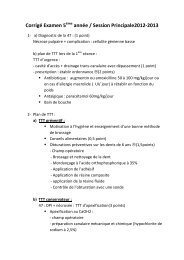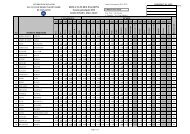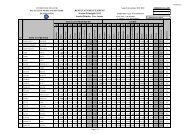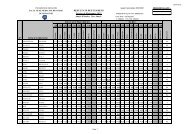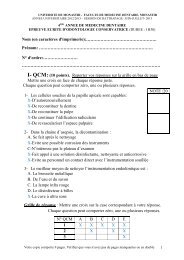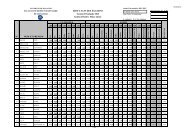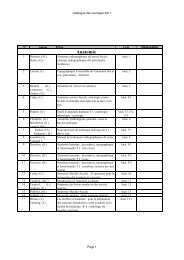Programme - Faculté de Medecine Dentaire de Monastir
Programme - Faculté de Medecine Dentaire de Monastir
Programme - Faculté de Medecine Dentaire de Monastir
Create successful ePaper yourself
Turn your PDF publications into a flip-book with our unique Google optimized e-Paper software.
Vingt-et-unièmes Entretiens Odontologiques <strong>de</strong> <strong>Monastir</strong>, 26-27 avril 2013<br />
L4. Approche clinique <strong>de</strong> la stratification antérieure <strong>de</strong>s résines composites.<br />
E. Hidoussi, A. Kikly, S. Sahtout, MS. Belkhir<br />
Introduction: Les restaurations antérieures directes en résine composite par la technique <strong>de</strong><br />
stratification ont connu un développement important ces <strong>de</strong>rnières années en raison <strong>de</strong> progrès<br />
importants au niveau <strong>de</strong>s propriétés mécaniques mais surtout optiques <strong>de</strong>s résines composites.<br />
Objectif: Le but <strong>de</strong> notre travail est d'illustrer à travers quelques cas cliniques le protocole<br />
opératoire <strong>de</strong> la stratification antérieure <strong>de</strong>s résines composites.<br />
Observations cliniques:<br />
• La restauration nécessite la mise en place d'un champ opératoire (digue) en dégageant<br />
toutes les <strong>de</strong>nts antérieures.<br />
• La réussite <strong>de</strong> cette technique se base essentiellement sur une bonne lecture <strong>de</strong> la<br />
macrogéographie et sur la détermination <strong>de</strong>s 5 dimensions <strong>de</strong> la couleur <strong>de</strong> la <strong>de</strong>nt<br />
(chromaticité, luminosité, les intensifs, les opalescents et les caractérisations.<br />
• Le support <strong>de</strong> la stratification est une clef en silicone qui permet la réalisation d'un mur<br />
palatin avec une résine composite <strong>de</strong> teinte émail<br />
• Cette technique propose <strong>de</strong> reconstituer le corps <strong>de</strong> la <strong>de</strong>nt avec <strong>de</strong>s masses <strong>de</strong>ntines plus<br />
ou moins opaques et <strong>de</strong> modifier la luminosité et la saturation avec un émail plus ou moins<br />
transluci<strong>de</strong> en améliorant l'opalescence.<br />
Conclusion:<br />
Cette technique permet <strong>de</strong> reproduire la morphologie <strong>de</strong> la <strong>de</strong>nt tout en garantissant un résultat<br />
esthétique reproduisant l'aspect d'une <strong>de</strong>nt naturelle.<br />
L5. Amelogenesis Imperfecta and kidney <strong>de</strong>ficiency.<br />
N.H. Zorgui, H. Féki, S. Bagga, N. Douki<br />
Background: Amelogenesis imperfecta (AI) is a diverse group of hereditary disor<strong>de</strong>rs that<br />
primarily affect the quantity, structure, and composition of enamel .The inheritance pattern of AI<br />
may be autosomal dominant, autosomal recessive, or X-linked . According to the Witkop<br />
classification system, there are four main forms of AI: type I hypoplastic enamel, type II<br />
hypomatured enamel, type III hypocalcified enamel, and type IV hypomatured-hypoplastic enamel<br />
with taurodontism . Clinical presentation of AI varies consi<strong>de</strong>rably among the different AI types.As<br />
a genomic induced condition,AI may be associated with morphologic and/or biochemical changes<br />
elsewhere in the body.kidney's problems are the most common general condition associated to AI.<br />
Case Observation:<br />
8 years-old boy, kidney-transplanted with type IV AI consulted for multiple teeth restorations.<br />
Physical observation:<br />
8 year old boy with dwarfism rickets, normal weight, slightly hyperactive and normal skin color.<br />
Intra-oral examination:<br />
Mixed <strong>de</strong>ntition with generalized AI with areas of <strong>de</strong>fect in enamel thickness<br />
Treatment plan: Adhesive restorations of all teeth to <strong>de</strong>lay tooth structure further loss till the time<br />
when prosthetic restorations can be applied especially to molars.<br />
Conclusion: AI treatment is always a challenge due to tooth structure <strong>de</strong>fects but it becomes<br />
har<strong>de</strong>r when <strong>de</strong>aling with young children with infectious risk such as our case.<br />
M1. Closure of anterior distemas using direct resin composite technique: case report.<br />
R. Mabrouk, N. Aguir, MS. Belkhir<br />
Aims: This paper reports a case of diastemas closure in anterior teeth that was successfully<br />
treated by direct resin composite technique.<br />
One of the challenges in clinical esthetic <strong>de</strong>ntistry is closing anterior diastemas without creating<br />
'black triangles' between the teeth. The success of a restorative treatment in anterior teeth<br />
<strong>de</strong>pends on the esthetic integration between soft and hard tissues. Restorations inclu<strong>de</strong> two<br />
techniques: bilateral and unilateral techniques. The choice between these techniques <strong>de</strong>pends<br />
- 53 -



